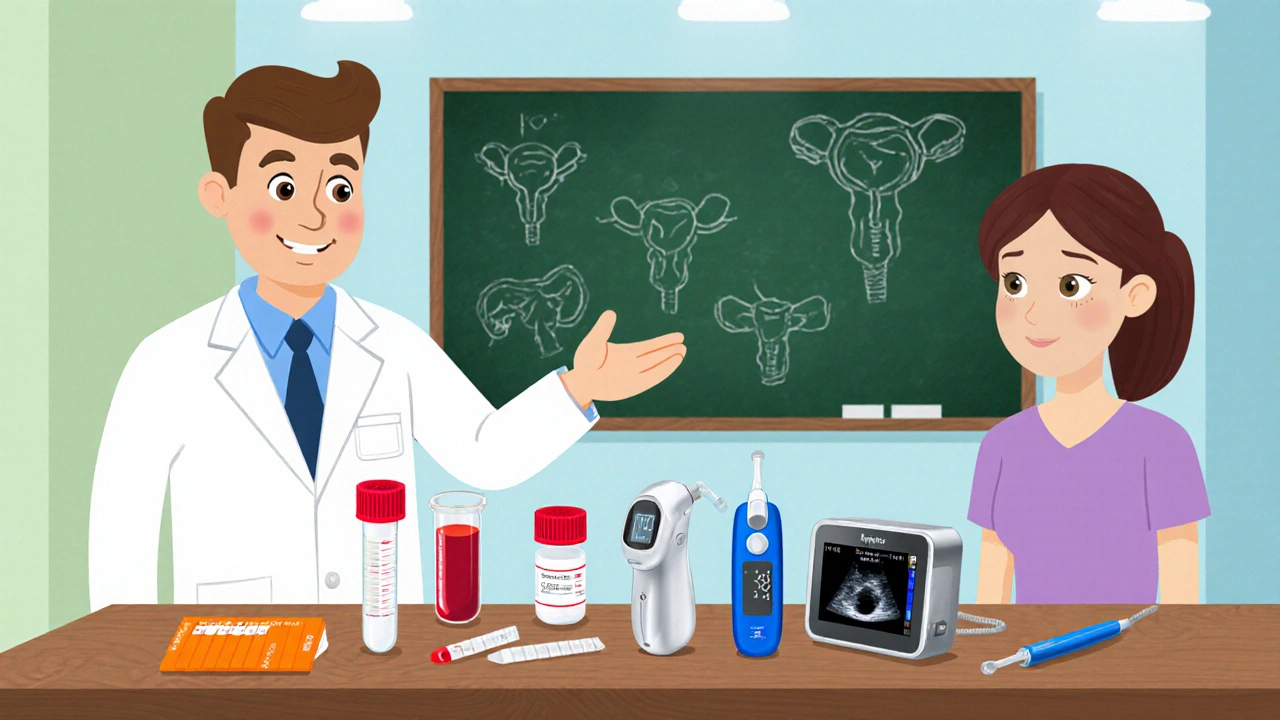Ovulation Test Selection Guide
Select your key factors below to see which ovulation test is best for your situation. This guide is based on the latest medical recommendations for conception.
Key Takeaways
- Know which ovulation tests suit your cycle before the appointment.
- Bring a brief symptom log and list of questions to help the doctor focus.
- Use clear, specific language - ask about test accuracy, timing, and next steps.
- Understand how results guide treatment options or lifestyle tweaks.
- Follow up with a written plan and know when to seek a second opinion.
Why Talking About ovulation testing Matters
When you’re trying to conceive, the conversation with your physician can feel intimidating. Yet, bringing up ovulation testing is the quickest way to turn vague concerns into actionable steps. Whether you’re tracking irregular periods, dealing with polycystic ovary syndrome (PCOS), or simply want to confirm your fertile window, a clear discussion helps the doctor recommend the most accurate test and avoid unnecessary extra appointments.
Understanding the Different Types of Ovulation Tests
There isn’t a one‑size‑fits‑all test. Below is a quick rundown of the most common options, each with its own strengths and limitations.
| Test | What It Measures | Best For | Typical Cost (USD) | Accuracy |
|---|---|---|---|---|
| Luteinizing hormone (LH) urine test a home‑based strip that detects the LH surge | LH surge (24‑36 hrs before ovulation) | Regular cycles, budget‑conscious users | $15‑$30 per pack | ~80‑90 % |
| Serum progesterone test blood draw performed in a lab | Progesterone level 7‑10 days post‑ovulation | Confirming ovulation after intercourse | $30‑$70 | ~95 % |
| Basal body temperature daily temperature tracking each morning | Post‑ovulatory temperature rise (≈0.3‑0.5 °C) | Women comfortable with daily logging | Free‑or‑low cost (thermometer) | ~70‑80 % |
| Fertility monitor electronic device measuring estrogen & LH | Hormone trends across the cycle | Irregular cycles, tech‑savvy users | $100‑$300 | ~90‑95 % |
| Mid‑cycle ultrasound transvaginal scan of follicles | Follicle size & development | Clinical evaluation, PCOS assessment | $150‑$400 per scan | ~98 % |

Preparing for Your Appointment
Doctors appreciate patients who come prepared. A simple checklist can make the conversation flow smoothly.
- Write down the dates of your last three periods.
- Note any symptoms: pelvic pain, spotting, mood swings, or changes in cervical mucus.
- Gather any over‑the‑counter fertility products you’ve tried (e.g., ovulation predictor kits).
- List specific questions (see the next section).
- Bring insurance information and a copy of previous lab results, if any.
How to Ask the Right Questions
Instead of vague statements like “I think I’m not ovulating,” frame your concerns with concrete language. Here are five question templates you can adapt:
- "Based on my cycle history, which ovulation test would give the most reliable results?"
- "If I have an irregular cycle, is a serum progesterone test or a fertility monitor more appropriate?"
- "What is the best timing for a urine LH test if I’m tracking my fertile window?"
- "Can you explain how a mid‑cycle ultrasound would help diagnose potential PCOS?"
- "If my test results are inconclusive, what are the next steps you recommend?"
Tailor the wording to match your comfort level; the goal is to keep the dialogue focused on actionable information.
Interpreting Test Results with Your Doctor
Understanding the numbers is half the battle. Here’s a quick guide to common result ranges and what they usually mean.
- Luteinizing hormone (LH) urine test: A dark line indicates a positive surge. If you don’t see a line after testing on two consecutive days, the test may be false‑negative.
- Serum progesterone test: Levels above 5 ng/mL typically confirm ovulation; lower values suggest no luteal phase.
- Basal body temperature: A sustained rise of 0.3‑0.5 °C for at least three days signals that ovulation has occurred.
Ask your doctor to place these numbers in context. For example, a borderline progesterone level might still be compatible with a successful pregnancy if you’re timing intercourse correctly.

Next Steps After Testing
Tests are a springboard, not a final verdict. Depending on the outcome, your doctor may suggest:
- Lifestyle tweaks: weight management, stress reduction, or timing intercourse every 2‑3 days.
- Medical interventions: clomiphene citrate for PCOS, timed intercourse with intrauterine insemination (IUI), or referral to a fertility specialist.
- Additional diagnostics: repeat serum progesterone, extended hormone panels, or a full reproductive endocrinology work‑up.
Make sure you leave the office with a written plan that includes dates for follow‑up appointments and any prescribed medication dosages.
Common Concerns and How to Address Them
It’s normal to feel anxious about cost, privacy, or test accuracy. Here’s how to bring those worries into the conversation.
- Cost: "Can you tell me which test offers the best value for my insurance coverage?"
- Privacy: "Will my test results be shared with anyone other than my primary care provider?"
- Accuracy: "What is the false‑positive rate for the LH test, and how can I minimize it?"
Doctors appreciate transparency and will usually have resources or referrals to help you manage these issues.
Quick Checklist Before You Leave the Office
- Did you receive written instructions for the recommended test?
- Is the follow‑up appointment date noted?
- Do you have a clear plan for timing intercourse or additional treatments?
- Have you clarified any insurance or cost questions?
- Is there a contact number for urgent questions before the next visit?
When should I start an ovulation test in my cycle?
For a typical 28‑day cycle, begin testing around day 10‑12. If your periods are shorter or longer, adjust by counting back 14 days from the expected next period and start 2‑3 days earlier.
Can I use an over‑the‑counter LH test if I have PCOS?
LH tests can still show a surge, but women with PCOS often have multiple small surges that make interpretation tricky. In such cases, a fertility monitor or serum progesterone test provides clearer data.
What does a low progesterone level mean after I’ve tested?
A low level (<5 ng/mL) usually indicates that ovulation didn’t occur or the luteal phase is short. Your doctor may suggest a repeat test, medication to induce ovulation, or further hormonal evaluation.
How often should I repeat ovulation testing if I’m not getting pregnant?
Track for at least three consecutive cycles. If results are consistently inconclusive, schedule a follow‑up with your gynecologist or an endocrinologist for a deeper work‑up.
Is it okay to discuss fertility concerns with a primary care doctor?
Yes. Primary care physicians can order basic tests and refer you to a specialist if needed. If you have a known condition like PCOS, seeing a gynecologist or endocrinologist early can speed up diagnosis.
 Sep, 5 2025
Sep, 5 2025

tatiana anadrade paguay
September 5, 2025 AT 20:23Having a solid prep sheet can really calm those pre‑appointment jitters. Start by jotting down the last three period start dates, then add any notable symptoms like spotting or mood swings. Bring your over‑the‑counter kits so the doctor can see exactly what you’ve tried. A brief list of specific questions-like which test aligns best with an irregular cycle-keeps the visit focused. Remember, a clear, concise log shows you’re engaged and makes the clinician’s job easier.
Diane Larson
September 17, 2025 AT 10:10Great points! I’d add that labeling each symptom with the day it occurred helps the doctor spot patterns you might miss. Also, ask about insurance coverage for the more expensive monitors; sometimes a lab‑based serum progesterone is covered but the home device isn’t. Don’t forget to request written instructions after the visit-having a printed plan beats trying to recall details later. If you feel rushed, politely ask for a quick recap before you leave.
Joey Yap
September 28, 2025 AT 23:56It’s fascinating how each testing method reflects a different aspect of the reproductive rhythm. The LH surge gives a narrow window, whereas basal body temperature offers a broader, retrospective view. Think of the tests as pieces of a mosaic that together illustrate fertility health. When you bring these perspectives to your doctor, you’re co‑creating a more nuanced picture. That collaborative mindset can reduce anxiety and empower decision‑making.
Lisa Franceschi
October 10, 2025 AT 13:43While the checklist outlined above is useful, it is prudent to consider additional dimensions that often escape initial consultations. First, a thorough review of your endocrine profile, including thyroid‑stimulating hormone and prolactin levels, can uncover hidden contributors to anovulation. Second, documenting lifestyle factors-such as caffeine intake, exercise frequency, and sleep quality-provides the clinician with variables that may influence hormonal balance.
Third, it is advisable to request a detailed explanation of the sensitivity and specificity of each proposed test, particularly in the context of polycystic ovary syndrome, where multiple LH surges can confound interpretation. Fourth, when discussing cost, inquire whether a stepped approach-beginning with low‑cost urine LH kits before escalating to serum assays-might be a viable insurance‑friendly pathway.
Fifth, ask for a timeline that includes anticipated follow‑up dates, enabling you to track progress and adjust interventions promptly. Sixth, ensure that any prescribed medication dosage is accompanied by clear instructions regarding timing relative to the identified fertile window.
Seventh, request that all recommendations be documented in a written care plan, complete with contact information for urgent queries. Eighth, consider asking whether a referral to a reproductive endocrinologist would be beneficial should initial measures prove inconclusive.
Ninth, clarify the privacy protocol for your results; understanding data handling can allay concerns about confidentiality.
Tenth, if you are contemplating assisted reproductive technologies, seek clarification on eligibility criteria and success rates specific to your clinical picture.
Eleventh, explore supportive resources such as patient education workshops or counseling services that address the emotional components of fertility challenges.
Twelfth, ask about the possibility of integrating complementary approaches-such as acupuncture or nutritional counseling-within the overall treatment framework.
Thirteenth, verify that the laboratory performing serum assays adheres to standardized quality control measures.
Fourteenth, request a summary of potential side effects for any pharmacologic agents discussed, ensuring you are fully informed.
Fifteenth, finally, reaffirm that you understand each step of the plan and feel comfortable proceeding; a mutual acknowledgment fosters collaborative care.
Brian Klepacki
October 22, 2025 AT 03:30Ah, the drama of the fertility saga! Imagine the suspense of waiting for that neon line on an LH kit, like a cliff‑hanger in a thriller. Then the universe throws a curveball-multiple surges in PCOS-turning your hopeful plot into a medical labyrinth! But fear not, dear seeker, for the next chapter holds the hero: a high‑tech fertility monitor that deciphers the hormonal riddles.
Shermaine Davis
November 2, 2025 AT 17:16Sounds good, thanks!
Debra Johnson
November 14, 2025 AT 07:03One must recognize the ethical imperative to prioritize patient autonomy above all else; yet, too often the system imposes opaque cost structures that erode trust. It is incumbent upon clinicians to disclose not merely the nominal price tag, but the hidden fees that accompany laboratory processing. Moreover, the moral responsibility extends to safeguarding privacy-patient data should never be disseminated without explicit consent. The discourse around test accuracy must also be transparent; false‑positive rates are not mere statistics, they represent real emotional turbulence. Therefore, a balanced, ethically sound approach demands thorough, jargon‑free explanations, coupled with written summaries for patient reference. Only through such comprehensive communication can we mitigate the power asymmetry inherent in medical encounters.